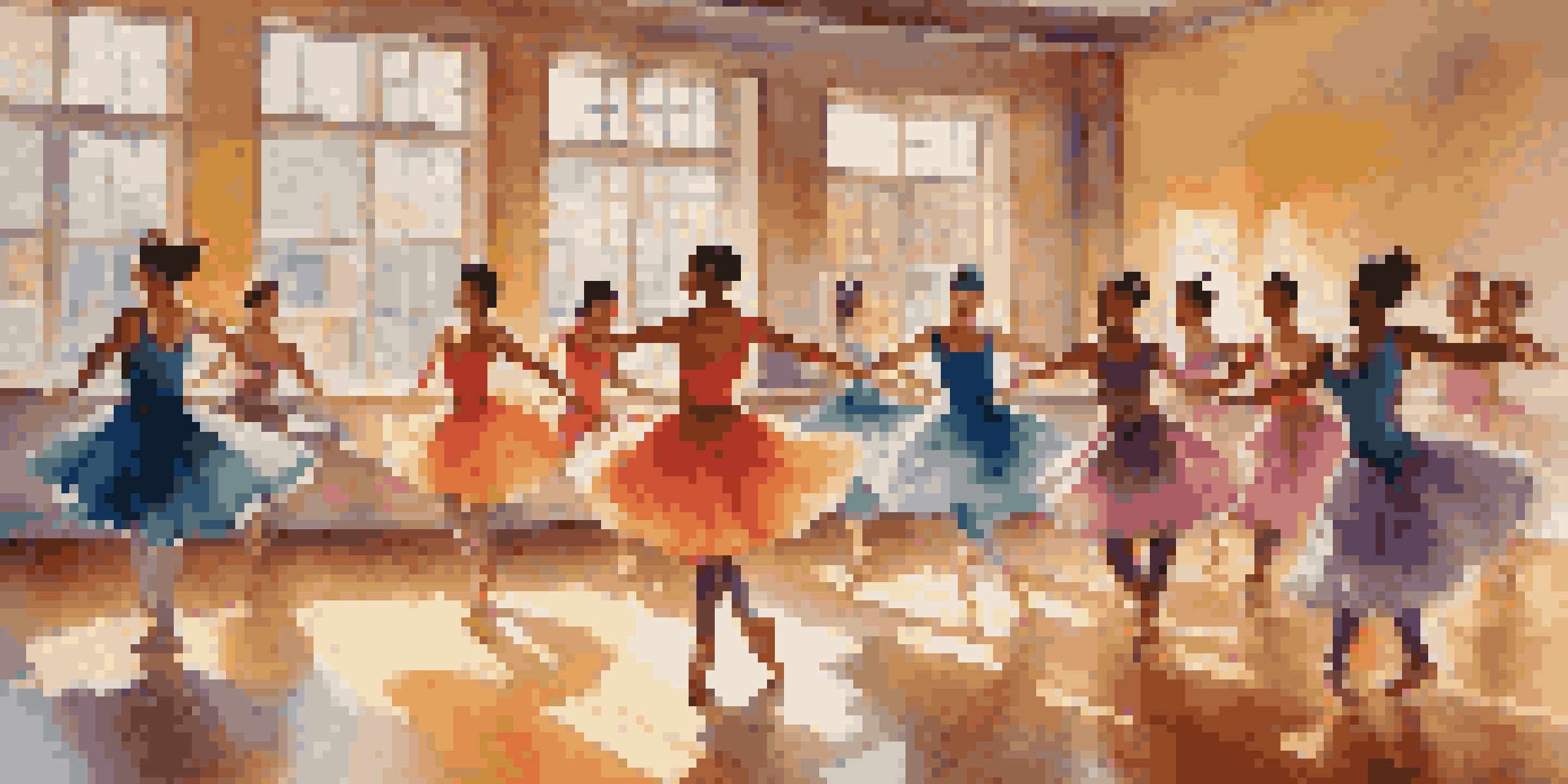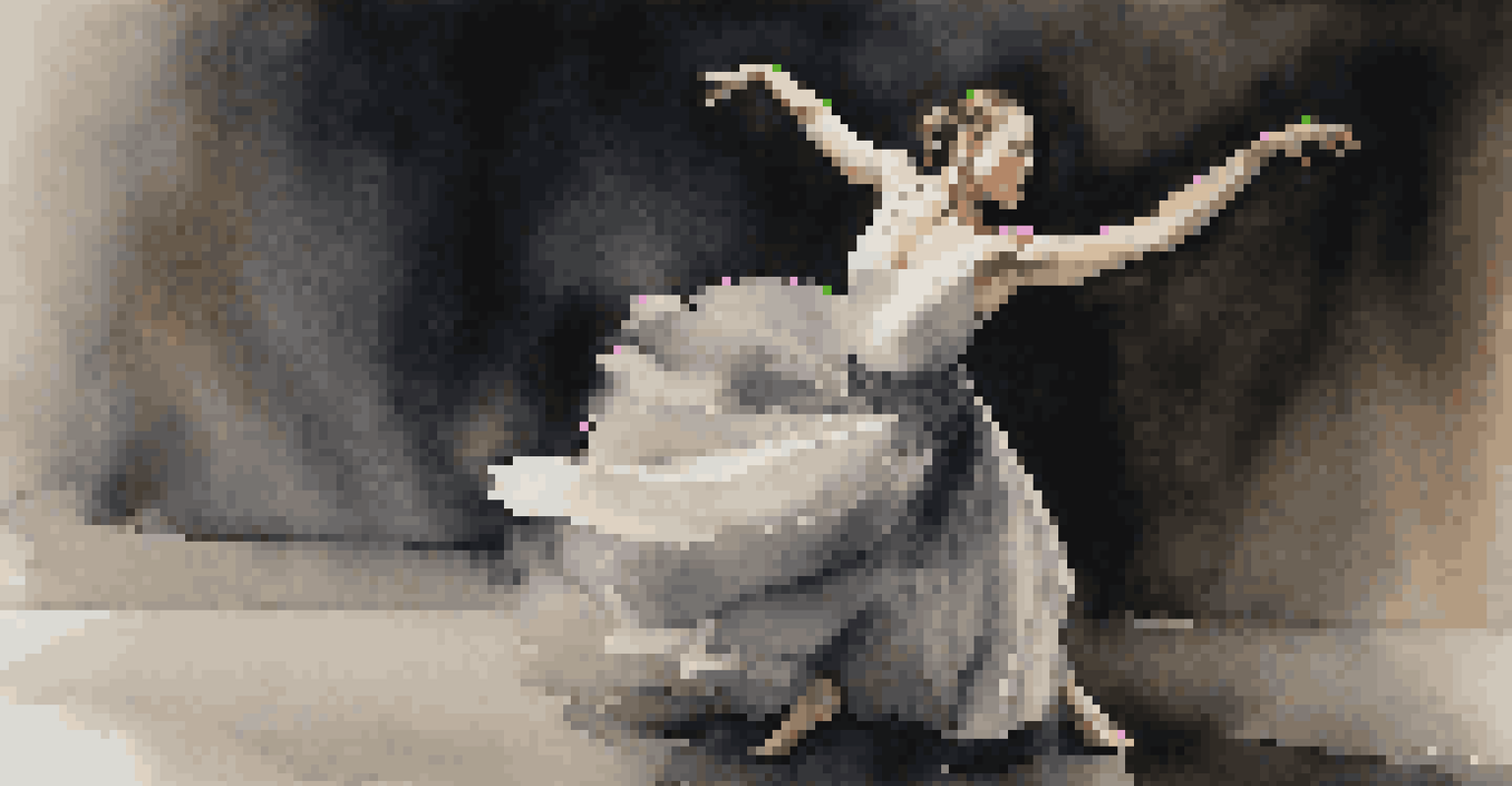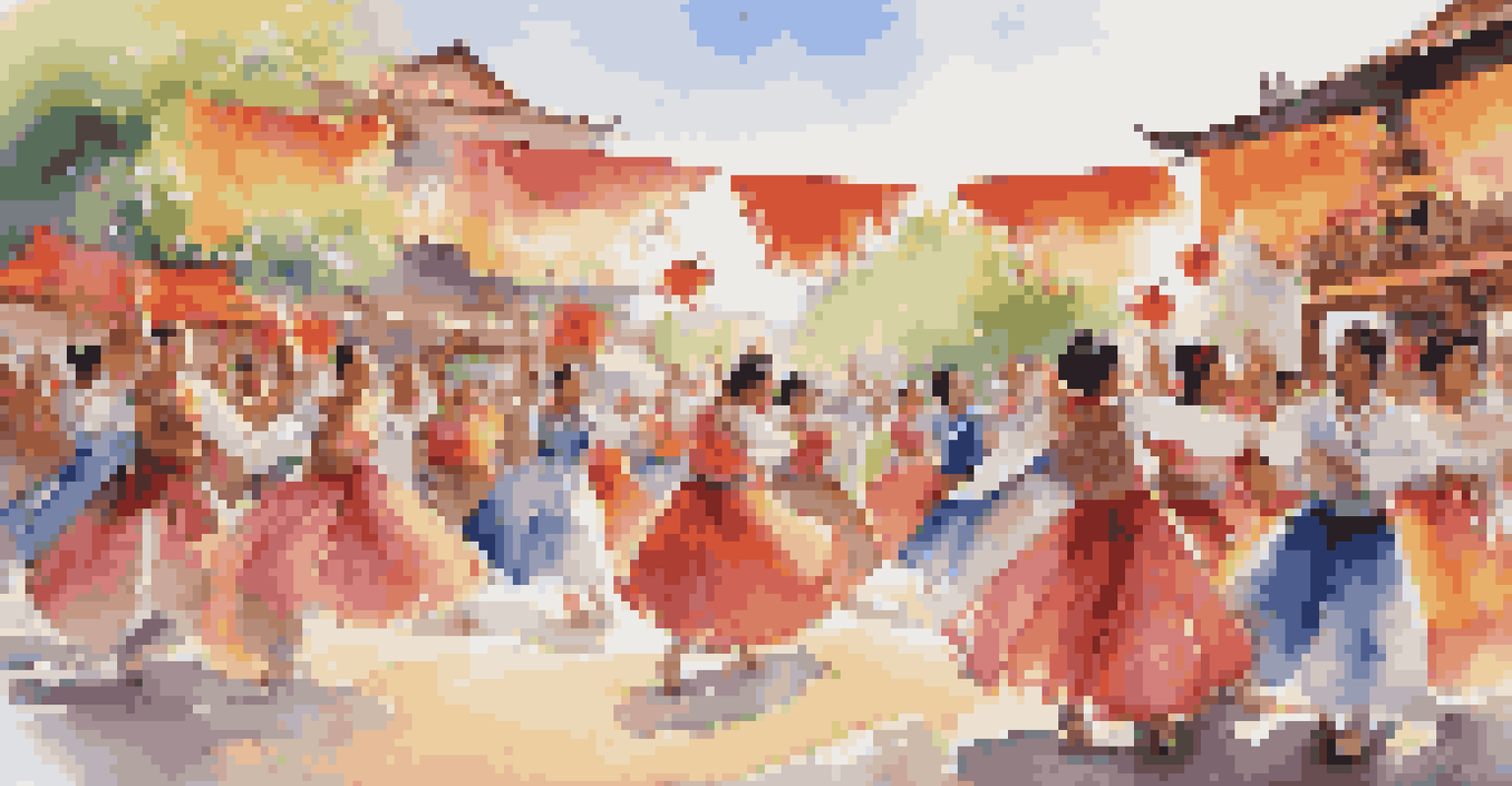Dance and Emotion: How Rhythm Influences Non-Verbal Cues

The Connection Between Dance and Emotion
Dance is often seen as a physical expression of emotion, where movements tell stories beyond words. Whether it’s a joyful celebration or a sorrowful farewell, the way dancers move can evoke deep feelings in the audience. This non-verbal communication transcends language barriers, allowing people from different cultures to connect through shared emotional experiences. Understanding this connection helps us appreciate the art of dance on a more profound level.
Dance is the hidden language of the soul.
When we watch a dancer, we don't just see their movements; we feel the energy they emit. Each twist, turn, and leap can resonate with our own emotions, making us feel joy, sadness, or even nostalgia. This emotional exchange is what makes dance such a powerful form of expression, capable of capturing the essence of human experience. It’s fascinating how rhythm and movement intertwine to create a language of their own.
Ultimately, the emotional impact of dance lies in its ability to mirror the complexity of our feelings. Just as music can lift our spirits or bring us to tears, dance has a unique way of embodying our inner emotional landscapes. This connection between dance and emotion highlights the importance of rhythm in conveying feelings that words often fail to express.
How Rhythm Shapes Emotional Expression in Dance
Rhythm acts as the backbone of dance, guiding movements and influencing emotions. Different tempos and beats can evoke distinct feelings; for example, a fast-paced rhythm may generate excitement and energy, while a slow, steady beat can create a sense of calm or melancholy. Dancers can manipulate these rhythms to express a wide range of emotions, making rhythm a fundamental element in the art of storytelling through movement.

Consider a lively salsa dance, where the quick beats and syncopated rhythms create an atmosphere of joy and celebration. The dancers' bodies move in sync with the music, their smiles and laughter enhancing the overall emotional experience. In contrast, a contemporary dance set to a slow, haunting melody may evoke feelings of longing or introspection, with movements that are fluid and expressive. This illustrates how rhythm shapes not only the dance itself but also the emotions it conveys.
Dance Expresses Complex Emotions
Dance serves as a powerful form of non-verbal communication, conveying deep emotions that words often fail to express.
In essence, rhythm provides the framework for emotional expression in dance. Just as a painter uses colors to express their vision, dancers use rhythm to communicate their feelings. Understanding this relationship allows us to appreciate the depth of emotion embedded in each performance, reinforcing the idea that rhythm is not just a background element but a vital part of the dance narrative.
Non-Verbal Cues: The Language of Dance
Non-verbal cues are essential in dance, allowing performers to communicate without words. These cues include facial expressions, body language, and gestures, all of which complement the rhythm and enhance the emotional narrative. For instance, a dancer's smile or frown can significantly alter the audience's perception of a performance, underscoring the emotional tone set by the rhythm.
Rhythm is the heartbeat of the universe.
Think of a ballet performance where the dancers' expressions shift from joy to sorrow as the music changes. Their graceful movements, combined with subtle facial cues, tell a story that resonates deeply with the audience. This synergy between rhythm and non-verbal communication creates a powerful emotional experience, making the performance memorable and impactful.
By paying attention to these non-verbal cues, audiences can engage more fully with the dance. It invites viewers to interpret the emotions behind the movements, fostering a deeper connection to the performance. This interplay between rhythm and non-verbal expression highlights the unique ability of dance to convey complex emotions in a way that transcends spoken language.
Cultural Influences on Dance and Emotion
Dance is deeply rooted in cultural traditions, and each culture has its own unique way of expressing emotion through movement. For instance, traditional African dance often incorporates energetic rhythms that express community joy and celebration, while Indian classical dance, like Bharatanatyam, uses intricate gestures to convey spiritual themes and emotions. These cultural influences shape how rhythm is perceived and utilized in dance.
When dancers perform within their cultural contexts, they draw upon a shared emotional vocabulary that resonates with their audience. This cultural connection enhances the emotional impact of the performance, as viewers can relate to the gestures and rhythms that reflect their own experiences. It’s a beautiful reminder of how dance serves as a universal language, yet is enriched by cultural diversity.
Rhythm Influences Emotional Impact
The tempo and beat of music shape the emotional experience in dance, allowing dancers to express a wide range of feelings.
In essence, understanding the cultural influences on dance allows us to appreciate the intricate ways rhythm and emotion are intertwined. By recognizing these connections, we gain insight into the rich tapestry of human expression that dance embodies, reminding us that every movement carries a story shaped by its cultural roots.
The Psychological Effects of Dance on Emotions
Engaging in dance has profound psychological effects, often elevating mood and reducing stress. The rhythm of the music, combined with physical movement, can trigger the release of endorphins, the body's natural mood lifters. This creates a feedback loop where the act of dancing not only expresses emotions but also influences them, making it a powerful tool for emotional well-being.
Consider how participating in a dance class can transform one’s day. The combination of rhythmic movement and social interaction fosters a sense of community and belonging. As participants immerse themselves in the dance, they often find themselves letting go of stress and embracing joy, illustrating how rhythm can positively impact emotions on both individual and communal levels.
Ultimately, the psychological benefits of dance highlight its role as a conduit for emotional expression and healing. By understanding this dynamic, we can appreciate dance not just as an art form but as a therapeutic practice that harnesses the power of rhythm to enhance our emotional health.
Dance Therapy: Using Rhythm to Heal Emotions
Dance therapy is a growing field that utilizes movement and rhythm to promote emotional healing. Through guided movement, individuals can explore their emotions in a safe space, allowing them to express feelings that might otherwise be difficult to articulate. This therapeutic approach embraces rhythm as a means of facilitating emotional release and personal growth.
In dance therapy sessions, participants engage in improvisational movement, which encourages spontaneity and self-exploration. The therapist may use specific rhythms to evoke particular emotions, helping individuals connect with their feelings on a deeper level. This can be particularly beneficial for those dealing with trauma, anxiety, or depression, as movement becomes a pathway to healing.
Cultural Roots Enhance Dance Meaning
Cultural influences enrich dance by providing a shared emotional vocabulary that resonates with both performers and audiences.
By integrating rhythm into therapeutic practices, dance therapy illustrates the profound impact of movement on emotional well-being. It shows us that through dance, we can not only express our emotions but also begin to understand and heal them. This connection between rhythm, dance, and emotional healing emphasizes the importance of movement in our lives.
The Future of Dance and Emotion in a Digital Age
As we move further into a digital age, the landscape of dance and emotion is evolving. Virtual platforms have made it possible for dancers to connect with audiences worldwide, sharing their emotional expressions through screens. This shift presents both challenges and opportunities for how we experience and interpret dance.
While online performances can reach broader audiences, they may lack the immediacy and intimacy of live experiences. Dancers are now exploring innovative ways to use technology, such as immersive virtual reality, to create emotional connections that resonate deeply with viewers. This adaptation highlights the resilience of dance as an art form and its ability to evolve while maintaining its core essence.

Looking ahead, the interplay between dance, rhythm, and emotion will continue to adapt to technological advancements. As we embrace these changes, it's essential to remember that the heart of dance lies in its capacity to connect us emotionally, reminding us that no matter the medium, the power of rhythm to convey feelings remains timeless.